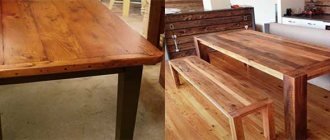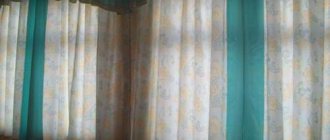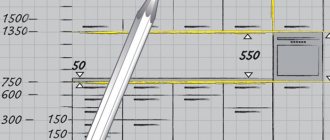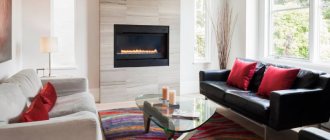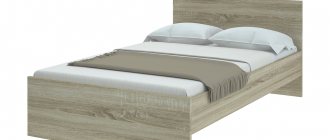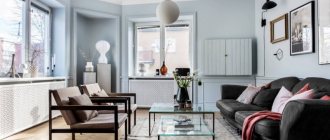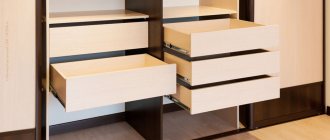All educational institutions need quality furnishings. According to the standards prescribed in the legislation of the Russian Federation, any piece of furniture used in a school must meet safety and comfort standards. Their parameters must correspond to the child’s growth, which is especially important for the primary grades, since in this period children grow quickly. The production of these products is carried out in compliance with all laws, thanks to which the educational process proceeds without any violations of posture, vision and other health problems. Below is information about the marking of furniture (desks and tables), its sizes in the table according to Sanitary Regulations in elementary schools.
Requirements
Standardized labeling indicators are specified in the regulatory document GOST 22046-2016 “Furniture for educational institutions. General technical conditions". This standard was approved by the Interstate Council for Standardization and is applied throughout Russia. According to this legislative draft, the bulk purchase of student equipment is permitted, which has undergone a preliminary strength test, taking into account the relevant documentation.
Furnished products for student use must have the following parameters:
- The gloss of the coating is no more than 49%.
- The working surface is easy to clean from dirt. Science classroom tables are equipped with a protective layer against chemicals.
- Compliance with all epidemiological standards.
The dimensions of educational furniture and its marking at school (according to SanPiN) are far from the only conditions that must be met. Requirements are also put forward for assembly:
- Reliable fixation of all structural parts.
- Impossibility of manually separating hardware elements.
- The absence of any irregularities on the outer surface. Sharp edges are rounded and holes in metal pipes with a diameter greater than 7 mm are closed or hidden.
- Contaminating parts are hidden.
GOST 22360-95 regulates the proper fixation of large objects:
- A strong and immovable connection of all parts of the structure and the impossibility of disassembling it manually.
- Reliable fastening of the stand (if available) to the object.
Furniture used in educational institutions must have special markings, which are indicated in Russian or the official regional language. It is prohibited to make any marks on the work surface. Tables are marked using special colored stickers that correspond to the height categories of GOST 11015 and 11016.
Legal requirements
The technology requirements are set out in the regulatory document GOST 22046-2016 “Furniture for educational institutions. General technical conditions", which is an interstate standard for Russia, approved by the Interstate Council for Standardization, Metrology and Certification on December 19, 2021.
The general requirements correspond to the state standard. A unified documented regulation allows for the mass purchase of student furniture for schools in all regions of Russia. All products undergo strength tests in accordance with the prescribed documentation.
School furniture according to GOST 22046-2016 must have the following parameters:
- The gloss of the coating does not exceed the permissible 49%.
- The surface is easy to clean. Science classroom tables are equipped with protection against reagents.
- The work surface meets current durability standards.
Requirements for assembling school furniture sets:
- All structural elements are securely fixed.
- Hardware parts cannot be separated by hand.
- Any unevenness on the exterior of furniture is unacceptable. Sharp edges should be rounded. The openings of metal pipes with a diameter greater than 7 mm are closed or hidden.
- Staining elements are hidden.
Proper fixation of large furniture is regulated by GOST 22360-95:
- The structural elements are carefully connected to each other and cannot be disassembled manually.
- If a stand is provided, its connection to the object must be reliable.
Furniture in the school has special markings, which are written in Russian or the official language of the region. Placement of marks on work surfaces is not permitted. It is necessary to mark desks with colored stickers corresponding to height categories according to GOST 11015, 11016.
The marking contains the following:
- information about the manufacturer;
- his contact details;
- trademark;
- description of the purpose of the item;
- designation of the current standard;
- production date, warranty period.
Prefabricated furniture with many parts may not be marked immediately upon manufacture, but should receive one upon packaging. It is necessary to have instructions containing the installation sequence with the obligatory presence of at least one picture demonstrating what the educational furniture will look like when assembled.
Desk number (according to Sanitary Regulations) and the size of educational furniture according to the student’s height, table
Experts have developed a size table that provides for the division of furniture into 6 groups. Such a classification makes it possible to differentiate it depending on the growth of children, thanks to which they can sit safely and comfortably at tables without damaging their eyesight or posture while doing any work (reading, writing, drawing and much more).
How many sizes are there for school furniture?
2021-06-15 2021-06-15 Metaline Metaline Metaline
https://artameb.ru
School furniture is specific in that it is color coded in accordance with the height group of children. This is especially important for primary and secondary classes, when children grow quickly and it is necessary to ensure that they are all sitting at the correct desks. Working for a long time on furniture that does not correspond to the child’s height is fraught with serious health consequences.
Features of school furniture
School furniture is subject to requirements for safety, ergonomics, and durability. Also, desks and chairs must comply with sanitary and hygienic standards and GOSTs from 2010. Also, furniture for educational institutions must receive a certificate of conformity. School furniture must be very durable because children are often inattentive to public or private property. And sometimes - too carefully, so desks and chairs must be disassembled only with the help of a special tool or cannot be disassembled.
In terms of manufacturing materials, school furniture is made of metal pipes as a frame. Table tops are most often made of 16 mm thick laminated chipboard. The seats and backs of the chairs are made of bent plywood - this is one of the most popular materials for schools. There are no longer benches for seating anywhere. Specific furniture for physics, chemistry, labor classrooms is equipped with special additions - washing baths, extensions. Also in schools, light and compact educational workbenches are installed in labor rooms for boys. Sewing equipment is installed in labor rooms for girls.
Features of marking school furniture
School furniture must be marked in accordance with the height group of the children who will work on it. The classification is unchanged and the same for all schools and lyceums.
| Height group | Child's height | Marking color | Table height | Chair height |
| 1 | 100-115 cm | Orange | 46 cm | 26 cm |
| 2 | 115-130 cm | Violet | 52 cm | 30 cm |
| 3 | 130-145 cm | Yellow | 58 cm | 34 cm |
| 4 | 145-160 cm | Red | 64 cm | 38 cm |
| 5 | 160-175 cm | Green | 70 cm | 42 cm |
| 6 | Above 175 cm | Blue | 76 cm | 46 cm |
There is also a zero group, which is not included in this table, since it is used mainly in kindergartens and other preschool institutions. Tables and chairs in this group are intended for children less than 95 cm tall. The first and second height categories are also rare - children with a height of about 130 cm go to the first grade. Thus, out of seven height groups of children, you can meet four or five.
Ready-made solutions for all areas
Stores
Mobility, accuracy and speed of counting goods on the sales floor and in the warehouse will allow you not to lose days of sales during inventory and when receiving goods.
To learn more
Warehouses
Speed up your warehouse employees' work with mobile automation. Eliminate errors in receiving, shipping, inventory and movement of goods forever.
To learn more
Marking
Mandatory labeling of goods is an opportunity for each organization to 100% exclude the acceptance of counterfeit goods into its warehouse and track the supply chain from the manufacturer.
To learn more
E-commerce
Speed, accuracy of acceptance and shipment of goods in the warehouse is the cornerstone in the E-commerce business. Start using modern, more efficient mobile tools.
To learn more
Institutions
Increase the accuracy of accounting for the organization’s property, the level of control over the safety and movement of each item. Mobile accounting will reduce the likelihood of theft and natural losses.
To learn more
Production
Increase the efficiency of your manufacturing enterprise by introducing mobile automation for inventory accounting.
To learn more
EGAIS
Eliminate errors in comparing and reading excise duty stamps for alcoholic beverages using mobile accounting tools.
To learn more
RFID
The first ready-made solution in Russia for tracking goods using RFID tags at each stage of the supply chain.
To learn more
Certification for partners
Obtaining certified Cleverence partner status will allow your company to reach a new level of problem solving at your clients’ enterprises.
To learn more
Inventory
Use modern mobile tools to carry out product inventory. Increase the speed and accuracy of your business process.
To learn more
Mobile automation
Use modern mobile tools to account for goods and fixed assets in your enterprise. Completely abandon accounting “on paper”.
Learn more Show all automation solutions
What does a set of office furniture consist of?
First of all, let's look at what rooms each modern office consists of. The main thing it consists of is its employees and their workplaces, as well as the reception areas where guests are greeted, meeting rooms and executive offices. So, no modern office can be imagined without:
- Tables, which come in various types. In terms of shape, there are straight, angular or ergonomic models, which are distinguished by an L-shaped tabletop and are most often equipped with mobile and attached cabinets. Also, tables are divided by design and purpose (meeting rooms, for managers, staff, visitors). Transforming tables are considered popular models recently. They are rarely used for workplaces. Most often they are used when arranging offices, in which the functionality and purpose often change. For example, today these are workplaces, tomorrow - a conference hall where people gather for negotiations, the day after tomorrow - a work class where trainings take place. Tables with variable height (from 600 to 1200 mm) are also becoming very popular. They are relevant for decorating workshops and work areas of architects and designers, since they allow you to perform work both sitting and standing.
- Desk screens and partitions, which have recently become increasingly important, as they allow not only to divide the workspace of each employee, but also to minimize contact between them. Table partitions can be made in addition to a series of furniture, or they can be made to order from various colors and materials (chipboard, fabric, wood, glass, plexiglass, in an aluminum frame). There are X-, W-, T- and U-shaped desktop screens.
- Chairs, armchairs and sofas, the choice of which is influenced by location and purpose.
- Booths - there are roll-out (mobile), attached, stationary, attached and others. Depending on the purpose, there are cabinets for documents, office equipment, service cabinets, and cabinets with a frigobar.
- Cabinets for documents or clothes. They can be open, closed, semi-closed, corner, narrow, high, low, deep. Also, there are sliding wardrobes equipped with a combination of different compartments, shelves, doors, so they can accommodate not only clothes, but also other things, incl. and documents.
- Shelving - for storing various types of documentation.
- Additional accessories.
How many height sizes are there for school furniture?
The size chart is based on various indicators: the height of the child, the height of the table and chair. Then the distribution and selection of optimal furniture products were carried out, which are manufactured for use in educational institutions. Today there are 6 main groups. There is also a zero one, but it is relevant for preschool institutions. The first two groups are practically not used, since they assume the height of first-graders to be less than 130 cm.
The above table for the size of desks in elementary schools according to SanPiN will help to compare the requirements of the standards with actual readings. With its help, you can correctly (from the legal point of view) purchase and arrange equipment that will pass any inspections and also ensure the most comfortable learning process.
Adjustable and non-adjustable school furniture
As we have already found out, desks and chairs can have a fixed height corresponding to a certain height group, or they can be adjusted. In the latter case, the frame of the product allows it to be fixed in several positions. Typically, this is a range of three height groups, for example 1-3, 2-4, 3-5, 4-6, 5-7.
Quite rarely, adjustment occurs immediately over a large range of sizes, for example 1-6. After all, according to the standards, in addition to height, other parameters also change, for example, the width of the seat. It will not be possible to make a universal seat for a primary school student and a high school student.
Growing furniture allows you to use the same model for a long time. Children grow up very quickly. And often the range of one height group is not enough even for a year. And using furniture of inappropriate sizes for children is simply dangerous. This is fraught with serious problems with posture and the musculoskeletal system in the future.
Despite the fact that initially growing furniture was intended exclusively for use in educational institutions, it is now quite often purchased for home use. Schoolchildren used to spend a lot of time at home doing homework and extracurricular activities. And now the share of distance learning has also increased significantly, which makes the use of student furniture in the apartment even more relevant.
Equipment of premises according to GOST
Each individual auditorium or class in educational institutions must be equipped taking into account the standard established by law. The arrangement of offices varies depending on its purpose. However, an important point is the need for all interior items.
Classrooms
Taking into account GOST 22046-2016, the audience includes:
- Desks.
- Chairs.
- Teacher's desk.
- Benefit lockers.
Additionally, there may be a wardrobe, a bedside table for storing posters and shelves for various purposes.
Library
The main task of the library is to provide children with access to the literary archive, as well as works that are included in the school curriculum. These can be magazines, popular science publications, textbooks, etc. In addition, all books issued for the period of study are stored here. Necessary:
- wide cabinets for textbooks and manuals;
- chairs;
- reading tables.
Also, marking school furniture according to SanPiN may be necessary for sofas, shelves and stands.
Dining room
This is a wide and spacious room that can accommodate many children during lunch breaks. It will require both perfect compliance with sanitary standards and a beautiful interior. Mandatory components of the dining room are:
- Dining tables of different sizes (large, medium and small).
- Benches or chairs.
Assembly Hall
It is used for festive celebrations and various events. Its main task is the ability to accommodate many spectators who can fully observe what is happening on stage. In parallel with this, it is necessary to ensure easy change of furniture for the assembly hall and the possibility of its removal to other rooms for holding public meetings. Based on this requirement, the mandatory elements of the halls are connected and separate chairs.
No additional furniture items are needed here. This is due to the fact that the main emphasis is on stage organization and technical equipment for performance and sound reinforcement.
Subject classrooms
They involve conducting various experiments and laboratory work using various devices and chemicals. For the physics classroom you need:
- stands;
- laboratory tables;
- teaching table for demonstration;
- cabinets for reagents with symbols.
There are no particularly stringent requirements for classrooms where subjects such as fine arts and drawing are taught. Classes are held on standard desks, but wooden easels and drawing boards are useful for comfortable studying.
At the personal request of the management (director), it is possible to additionally place separate wardrobe lockers for students, which replace the classic hooks in the corridor.
Types of school furniture
Each classroom must be equipped in accordance with SanPiN standards. A standard set of furniture in a classroom or student auditorium includes:
- desks;
- chairs;
- teacher's desk;
- cabinets for storing educational materials and aids.
Depending on the area and purpose of the office, its equipment may vary. There are several main types of classrooms:
- audiences and classes;
- subject classes that require the placement of visual aids, as well as special tables for conducting experiments and laboratory work (physics, chemistry, biology and geography classrooms);
- teachers' rooms or rooms for teachers;
- assembly halls;
- libraries;
- dining rooms
There are a number of general requirements for school furniture. Conventionally, they can be divided into the following groups:
- Pedagogical. Furniture for a physics and chemistry classroom will differ in its configuration from the desks and tables for regular school classrooms. It is important to take into account the specifics of the classroom. Some require cabinets with spacious niches for visual aids or equipment (microscopes, flasks, etc.).
- Sanitary and hygienic. The material and coating of student furniture for school must be safe, non-toxic and resistant to different temperatures. Also, countertops should be smooth and well-finished so that there is no risk of injury. Delamination of wood on chairs and desks is excluded, as this can lead to splinters and other injuries. It is important to replace furniture damaged during long-term use as soon as possible.
- Ergonomic. All student furniture should be comfortable and safe to use. To do this, it is necessary to take into account the average weight and height of students of a certain age group, and depending on this, select the height and size of the working surface of the desk. Also, for safety, the corners of the desks are made beveled or rounded. In addition, a plastic edge is used around the perimeter of the tabletop. The frame is made stable so that the desks do not wobble even on uneven surfaces. Ergonomic requirements also include the distance at which desks are located between each other and from the board. The width of the aisles between rows of desks must be at least 60 cm, and the board must hang at a distance of 2.4 m from the first desk.
- Durability requirements. The better and more durable the furniture for the school, the less often you will have to update the classroom stock. This will reduce the economic burden and allow you to immediately replace failed interior items.
- Architectural and artistic. Student furniture should be aesthetic and modern, and also be combined with other interior items in the classroom. With the help of furniture, you can create a harmonious atmosphere in the classroom, in which it will be comfortable to conduct classes.
This is interesting: Variety of wardrobes for children's rooms, reasons for their popularity
Standard dimensions of furniture and its markings
State standards clearly describe the amount of space required for all types of products, as well as their required height. Eg:
- GOST 18314-93. Tables for laboratory work: dimensions according to height markings; 2-seater with a working area of 1300 mm and 3-seater with 1950 mm are possible; the height of the boot along the lid is less than 60 mm.
- GOST 19549-93. Furnished products for drawing: dimensions according to height markings; corners of the stand and desk lids with rounded edges within a radius of at least 10 - 30 mm; the location of removable music stands is at least 300-400 mm from the lid.
- GOST 5994-93. The width of the hinged lid (if available) is from 10 to 180 mm; 2-seaters are equipped with space of 450x270 centimeters for briefcases; the surface of the seats is flat or with a recess in the center of no more than 10 mm; corners of the table and desk top with rounded corners within a radius of at least 10-30 mm.
Standard sizes
When making furniture for educational institutions, it is necessary to comply with the required dimensions. State standards clearly describe how much occupied space is provided for each type of product, and what height they should be. For example:
- GOST 5994-93. Desks - sizes according to height markings. The width of the hinged lid (if any) is 160-180 mm; double rooms are equipped with a space of 450 x 270 cm for backpacks; the seat surface is flat or with a central recess of no more than 10 mm; The corners of the table and desk lid are rounded within a radius of at least 10-30 mm.
- GOST 11016-93. Chairs – marked sizes from 1 to 7 for the average height of schoolchildren from 1.05 to 1.9 m in increments of 15 cm.
- GOST 18314-93. Laboratory tables: dimensions according to height markings; doubles with a working area of 1300 mm and three-seaters with an area of 1950 mm are allowed; the height of the side along the lid is no more than 60 mm; placement of laboratory sinks - no closer than 240 mm from the table top.
- GOST 19549-93. Drawing furniture: dimensions according to height markings; the corners of the table and desk top are rounded within a radius of at least 10-30 mm; placement of removable music stands - no closer than 350-400 mm from the side of the lid.
Compliance with height charts is mandatory and depends on the age category of the students. For example, small desks and chairs are not acceptable in high schools.
Materials
For products installed in educational institutions, soft wood and plastic are used in production. Based on GOST 30255-95, the use of raw materials even with a minimal content of toxic substances is prohibited. Desks and bookcases are made from chipboard with class E1, chairs are made from solid wood or solid wood. The internal part is sealed with PVC sheets. Metal frames are treated with polymer paint. It is also used to cover tables for chemistry and physics classes, as it increases resistance to chemicals. Marking furniture in schools according to SanPiN requires mandatory treatment of wooden products with a special varnish.
The material can be considered suitable if the following conditions are met:
- No foreign fluff, unevenness or roughness.
- There are no unpleasant or pungent odors.
- There is no contamination with radionuclides (the maximum permitted background is less than 300 Bq per 1 kg of weight).
- Resistant to heat and chemicals.
- Low thermal conductivity (less than 0.46 W).
Business Solutions
- the shops
clothes, shoes, products, toys, cosmetics, appliances Read more
- warehouses
material, in-production, sales and transport organizations Read more
- marking
tobacco, shoes, consumer goods, medicines Read more
- production
meat, procurement, machining, assembly and installation Read more
- rfid
radio frequency identification of inventory items More details
- egais
automation of accounting operations with alcoholic beverages Read more
- The gloss of the coating is no more than 49%.
- The working surface is easy to clean from dirt. Science classroom tables are equipped with a protective layer against chemicals.
- Compliance with all epidemiological standards.
Furnished products for student use must have the following parameters:
The dimensions of educational furniture and its marking at school (according to SanPiN) are far from the only conditions that must be met. Requirements are also put forward for assembly:
- Reliable fixation of all structural parts.
- Impossibility of manually separating hardware elements.
- The absence of any irregularities on the outer surface. Sharp edges are rounded and holes in metal pipes with a diameter greater than 7 mm are closed or hidden.
- Contaminating parts are hidden.
GOST 22360-95 regulates the proper fixation of large objects:
- A strong and immovable connection of all parts of the structure and the impossibility of disassembling it manually.
- Reliable fastening of the stand (if available) to the object.
Furniture used in educational institutions must have special markings, which are indicated in Russian or the official regional language. It is prohibited to make any marks on the work surface. Tables are marked using special colored stickers that correspond to the height categories of GOST 11015 and 11016.
Color and design
The correct selection of shade when creating furniture for student use plays an important role and is partly controlled by GOST 22046-2016. There is a color marking for furniture group 5 (desks) in a school according to SanPiN. The standard provides restrictions:
- Darkened details are allowed in the design of various stands for school supplies, as well as bookcases with light elements.
- The use of white desks is prohibited (excluding metal fastenings).
- According to Appendix A, it is recommended to give preference to a cold pastel palette for upholstery or paintwork.
How desks are marked in elementary school
Markings are applied to the visible side of chairs and desks in the form of classic circles with a diameter of 1-3 centimeters or colored stripes. The most convenient places for tables are: side leg, back surface, edge, if the lid is wide enough. Markings on chairs are carried out in the area of the rear surface of the back, the visible upper part of the metal frame.
The marking standards recommend that this be done symmetrically on both sides of any furniture used in educational institutions. Thanks to this, schoolchildren will quickly get used to the rules and will be able to navigate if necessary to change it to the desired size.
Marking of school furniture
Summary:
Marking of school furniture is carried out with complex equipment of objects. Thanks to it, the correct arrangement of desks and chairs in the classroom is observed and students are seated in accordance with their height. Contact the Nursery School for details.
- Marking school furniture according to size
The marking of school furniture is based on SanPiN and is based on height groups of furniture for schoolchildren that correspond to their height. Below, in the size table you will find compliance with GOST 11015 93, 11016 93
Several sets of student desks and children's chairs of different heights should be calculated and planned. We wrote about recommendations in a separate article. Teachers should help students know their height and compliance with the marked size of furniture. It is unacceptable to replace chairs with benches or armchairs, desks with bedside tables and other alternative pieces of school furniture instead of the main student desks and chairs.
It is recommended to post the correspondence table and color height guide in a visible place. And the school management should be provided with a visual representation in the form of marking of school furniture and availability of information about which color mark corresponds to the anthropometric parameters of the student.
The main task is to take into account the necessary proportions of purchased furniture sets, assumptions and restrictions.
- Rules for marking school furniture
School furniture must be marked on the visible side of chairs and desks. The usual designation is a circle with a diameter of 1-3 centimeters or colored stripes.
A convenient place for a desk: the side leg, the back surface of the desk, the edge of the student table, if the desk lid is wide enough.
Place of marking on the student chair: back surface of the back, visible upper part of the metal frame.
It is recommended to apply the markings symmetrically on both sides of the desk and chair and extend the rule to all furniture in the educational institution. In this case, students will quickly get used to the rule of marking school furniture and it will not be difficult to quickly find their way, take it or replace it with the right size.
When equipping a school with furniture, there are no unimportant issues. Imagine that they bring you 1000 sets of desks with chairs and all this is stored in one place, then you need to sort it, draw up a plan for placement into classes in accordance with the height proportions, and if you do not provide for the marking of school furniture on the furniture itself and packaging kits, real confusion awaits you and manual work, which will take a lot of time.
Head of Supply Department (Nursery School)
Even such seemingly trifles can take a significant amount of time to correct an error. Otherwise, you will have to use a ruler to determine which height group the furniture belongs to, which will take a lot of time and nerves.
- Where to get material for marking school furniture
Not all manufacturers take care of applying markings before the furniture leaves the conveyor to the warehouse and from the warehouse to the facility. As a rule, the more expensive the samples, the better the quality of pre-sale preparation. But, unfortunately, not everyone has the limits of specifications and the ability to replace them with alternative samples. The markings are only part of the additional options that are included in the kit.
For cases when it is impossible to obtain furniture in a prepared form, the Nursery School company has prepared its own set of marking elements with a good adhesive base, which is not subject to fading in the sun and abrasion. Also, if it is necessary to re-glue the markers, the adhesive base easily forms lumps and is removed without leaving any residue on the furniture.
Even before completing the facility with turnkey furniture and equipment, Nursery-School employees provide for such little things as labeling of school furniture, and in any case: whether you carry out the arrangement on your own, or with the help of Nursery-School employees, you will always have a marking aspect. The strength of professionals lies in the details.
If you want to order a set of stickers, you can receive them for free by sending a request to, through the feedback form on the website, or through contacts in the “Contacts” section.
Company phone number. We will answer at a time convenient for you. And for greater convenience, a chat function is provided.
Your Nursery School.
Ready-made solutions for all areas
Stores
Mobility, accuracy and speed of counting goods on the sales floor and in the warehouse will allow you not to lose days of sales during inventory and when receiving goods.
To learn more
Warehouses
Speed up your warehouse employees' work with mobile automation. Eliminate errors in receiving, shipping, inventory and movement of goods forever.
To learn more
Marking
Mandatory labeling of goods is an opportunity for each organization to 100% exclude the acceptance of counterfeit goods into its warehouse and track the supply chain from the manufacturer.
To learn more
E-commerce
Speed, accuracy of acceptance and shipment of goods in the warehouse is the cornerstone in the E-commerce business. Start using modern, more efficient mobile tools.
To learn more
Institutions
Increase the accuracy of accounting for the organization’s property, the level of control over the safety and movement of each item. Mobile accounting will reduce the likelihood of theft and natural losses.
To learn more
Production
Increase the efficiency of your manufacturing enterprise by introducing mobile automation for inventory accounting.
To learn more
EGAIS
Eliminate errors in comparing and reading excise duty stamps for alcoholic beverages using mobile accounting tools.
To learn more
RFID
The first ready-made solution in Russia for tracking goods using RFID tags at each stage of the supply chain.
To learn more
Certification for partners
Obtaining certified Cleverence partner status will allow your company to reach a new level of problem solving at your clients’ enterprises.
To learn more
Inventory
Use modern mobile tools to carry out product inventory. Increase the speed and accuracy of your business process.
To learn more
Mobile automation
Use modern mobile tools to account for goods and fixed assets in your enterprise. Completely abandon accounting “on paper”.
Learn more Show all automation solutions
Choosing the right office furniture
How can the head of a company or the employee responsible for furnishing an office not make a mistake when choosing modern, multifunctional furniture?! Especially if this process happens for the first time! Nowadays the market offers a large selection of office furniture, both domestic and foreign. Therefore, the future buyer will have a difficult selection.
When purchasing office furniture, be attentive to every detail. Attractive appearance plays a big role, however, convenience and versatility have a much more significant effect and significance on the performance of employees, and, as a result, the success of the company.
- Office furniture must be highly durable and wear-resistant. Take a closer look at fasteners, fittings, and retractable mechanisms. Furniture with eccentric ties (the so-called metal-to-metal fasteners) is more reliable. It is easy to disassemble and reassemble in a new place if you move.
- Buy furniture products designed exclusively for office premises. In this case, it will be much easier for you to choose the ideal solutions for arranging all workplaces and other office areas intended for certain purposes. Large organizations specializing in the production and supply of office furniture often offer multifunctional turnkey sets. In addition, they can produce customized solutions for you, taking into account the characteristics of your premises and wishes.
- In connection with the point mentioned above, the presence of its own production in an organization engaged in the sale of office furniture plays an important role. For example, you can place an individual order for the production and supply of the entire volume of furniture products or supplement an existing furniture interior with the necessary items. Such organizations provide comprehensive services from measuring premises, developing a design project, manufacturing furniture according to approved sketches, supplying new furniture, assembly, arrangement and much more.
- When purchasing upholstered furniture for the office, pay attention to the upholstery and filling material (how quickly its shape is restored depends on this). It is better to buy sofas and soft chairs with upholstery that does not require complex care and with medium-hard filling. Do not forget about the design, which should be harmoniously combined with the rest of the office interior, as well as with the corporate style. If difficulties arise when choosing sofas, you should use the service of individual tailoring to order in upholstery, material, category and color palette that most advantageously emphasize the corporate style of the company. Also, some office sofas have folding mechanisms, mostly the “French folding” type is used.
- We recommend choosing office furniture in the same style and the same type for different rooms (reception areas, meeting rooms, executive offices, waiting areas).
- The presentability and versatility of furnishings dictates the specific behavior of employees. Therefore, the height of tables, chairs, sofas in different spaces should also be perfectly combined.
- When setting up employee workplaces, massive tables and chairs should not be used (meaning supports on 4 legs, “runners”). This will be impractical and inconvenient, and may also cause back pain.
- If office work involves long-term storage of documents, then you should purchase cabinets and racks, and select their sizes depending on the format of the archive folders.
- The price of all of the above depends on the materials. For example, veneered furniture is characterized by high cost, but it is inconvenient to work on it without additional accessories such as a writing pad, so most often such furniture is suitable for VIP meeting rooms or an executive’s office. For furniture for staff, you can opt for products made from medium-density chipboard (MDSP), from economy to business class, basically all factories work with it, but the quality of the board differs depending on the specific manufacturer.
Where to get the material
Not all manufacturers are worried about the fact that after furniture products leave the assembly line for the warehouse and facility, desks and tables in an elementary school should be marked according to Sanitary Regulations and Regulations. High-quality pre-sale preparation is observed only with expensive samples. But unfortunately, not everyone has the limits of specifications and the ability to replace them with alternative options. Marking is only part of the options included in the main kit.
If it is impossible to receive the furniture in a prepared form, Cleverence will be able to solve this problem. We have at our disposal a marking kit with an excellent adhesive base, which is highly resistant to solar fading and abrasion that occurs during active and long-term use. If for some reason re-gluing is required, this base easily reverses lumps and is removed without the slightest residue.
Height groups of school furniture
Currently produced school furniture is subject to strict requirements regarding the quality of materials used and design dimensions.
To correctly select such school furniture, it is necessary to take into account height groups, which make it possible to simplify the selection of the necessary furniture designs. In the recent past, the concept of height groups for school furniture was virtually absent. Manufacturers made two types of school desks, which were intended for elementary grades, and full-size tables, which were used by students from fifth to eleventh grade. Today, several height groups are used at once, which allow optimizing the size of furniture corresponding to the height of the child.
So, in accordance with the current GOST, it is customary to distinguish seven main growth groups.
The zero growth group is intended primarily for preparatory school classes, where children from kindergarten are taught. Furniture of this height group is marked white and intended for children no taller than 90 centimeters. As mentioned above, such height-group furniture is used extremely rarely in schools.
For primary classes, furniture of the first height group is used. It is color coded orange and is intended for children no taller than 1 meter. The height of the chair in accordance with this height group is 26 centimeters, and the height of the table top is 45 centimeters.
The second height group is used quite often in grades four through six. These height groups of school furniture are designed for students no more than 120 centimeters tall and have a seat height of 30 centimeters and a tabletop height of 52 centimeters.
The third size of school furniture is color coded yellow and is intended for students from fifth to seventh grade. The furniture of this group is optimized for use by teenagers whose height does not exceed 135 centimeters. The height of the table top is 58 centimeters, and the height of the chair is 34 centimeters.
In the past, the fourth size of school furniture, indicated by red markings, was the last and was used from 8th to 11th grade. It is intended for students no taller than 150 centimeters. However, today, when there is an increase in the average height of schoolchildren, two additional height groups of school furniture have been added.
The fifth group of furniture is designed specifically for use in high schools and is intended for students whose height does not exceed 165 centimeters. This height group is marked green, and the height of the table top is 70 centimeters. School furniture of the fifth height group is most widespread in high schools. It is optimally suited to the height of students and ensures the most convenient and comfortable fit.
We also produce school furniture for the sixth height group, which limits the height of schoolchildren to 180 centimeters. The color marking of furniture of the sixth height group is done in blue. It must be said that furniture of this sixth group is used extremely rarely today, so in most cases it is made on an individual basis.
When choosing school furniture, it is necessary to take into account height groups, which will allow you to make the right choice. Currently, in the range of offers of specialized furniture factories, you can easily find options for school furniture, which differ in their dimensions and design style. All this greatly simplifies the choice and allows you to design school classrooms in an original and high-quality manner.
Choose furniture for your school on our website or consult the company’s managers by phone:
How to mark the numbers of desks and chairs by height (SanPiN)
Student furniture products must be marked taking into account the height group of the children who will study behind them. There is a single classification that remains unchanged and mandatory for all educational institutions. It includes several indicators: height group, marked color, table and chair height. On this basis, the following are distinguished:
- First: 110 - 115 cm, orange, 46 and 26 cm.
- Second: 115 - 130 cm, purple, 52 and 30 cm.
- Third: 130 - 245 cm, yellow, 58 and 34 cm.
- Fourth: 145 - 160 cm, red, 64 and 38 cm.
- Fifth: 160 - 175 cm, green, 70 and 42 cm.
- Sixth: over 175 cm, blue, 76 and 46 cm.
There is also a zero group that is not included in the main table. As a rule, it is installed in kindergartens and other preschool institutions. It is applicable for children whose height does not exceed 95 centimeters. The first and second categories are not common, since the average height of a child entering first grade is approximately 130 cm.
Compliance confirmation form
Confirmation of the safety and compliance of furniture products with the requirements of TR CU 025/2012 is carried out in the form of certification or declaration.
Furniture products intended for children and furniture for educational and preschool institutions (tables, chairs, beds, playpens, toy boxes, armchairs, sofas, cabinets, cabinets, stools, benches, mattresses, sofa beds and other products) are subject to mandatory certification. .
Household furniture and furniture for public premises are subject to declaration.
Equipment
The marking of furniture and its dimensions at school are determined by special labels. Use allows you to easily remove them from the surface without leaving adhesive residues. They do not interfere with students, are not conspicuous and can withstand any temperature changes.
Regardless of the selected technical equipment, the labeling content must necessarily include:
- Manufacturer information.
- His contact details.
- Trademark.
- Date of manufacture, warranty period.
- Description of the purpose of the item.
- A note about the current standard.
Adhering to these requirements of SanPiN, marking of desks and chairs (height) will be carried out correctly, from a legal and safe point of view.
Today, the issue of arranging classrooms in educational institutions is approached as strictly, responsibly and under the careful control of the rules established by law. These quality standards, which become even more convenient every year, are aimed at taking care of students of all ages. Compliance with all established standards greatly simplifies the life of both the student and the management. Knowing the requirements put forward by GOST will allow you to choose the right furniture manufacturer who will provide the required desk number according to height.
The learning process should always take place in a favorable atmosphere and cozy environment.
The creation of such conditions falls entirely on the shoulders of the director and the working team (educators, teachers and lecturers), who are responsible for the life and health of students. To gain knowledge, students should not be distracted and waste time looking for comfortable tables or chairs. Each classroom is initially equipped with the necessary equipment and items that are used for studying. However, they strictly comply with current standards and regulations, which are prescribed in order to achieve maximum safety and comfort. The size of school desks and furniture marked according to SanPiN, which describes in detail the necessary data and indicators, can help with this. Number of impressions: 59416
The problem of equipping schools with furniture.
In height-adjustable furniture, it is impossible to provide all chair sizes in accordance with the anthropometric data of students. At the same time, height-adjustable furniture has become the most widespread, taking into account a number of its advantages over non-adjustable furniture.
The main criterion when selecting student furniture to organize the optimal workplace for students is the length of its body.
To select educational furniture according to the height of students, its color marking is made, which is applied to the visible side outer surface of the table and chair in the form of a circle or stripes.
Equipping educational institutions with student furniture is regulated by the current Sanitary norms and rules “Requirements for institutions of general secondary education”, approved by Resolution of the Ministry of Health of the Republic of Belarus dated December 27, 2012 No. 206 (hereinafter referred to as the Sanitary Rules).
The size chart is based on various indicators: the height of the child, the height of the table and chair. Then the distribution and selection of optimal furniture products were carried out, which are manufactured for use in educational institutions. Today there are 6 main groups. There is also a zero one, but it is relevant for preschool institutions.
The above table for the size of desks in elementary schools according to SanPiN will help to compare the requirements of the standards with actual readings. With its help, you can correctly (from the legal point of view) purchase and arrange equipment that will pass any inspections and also ensure the most comfortable learning process.
To ensure standard levels of insolation and natural lighting of premises and playgrounds, when locating buildings of educational institutions, sanitary gaps from residential and public buildings must be observed.
These sanitary standards cover almost all possible forms of working with children and therefore it is quite difficult to navigate them and find the necessary information. Below are items that apply only to kindergartens and schools.
About dishes:
- The use of disposable tableware and cutlery is permitted. (clause 2.4.6.2)
- The use of deformed, defective or mechanically damaged kitchen and tableware and utensils is not allowed; cutlery (forks, spoons) made of aluminum. (clause 2.4.6.2)

